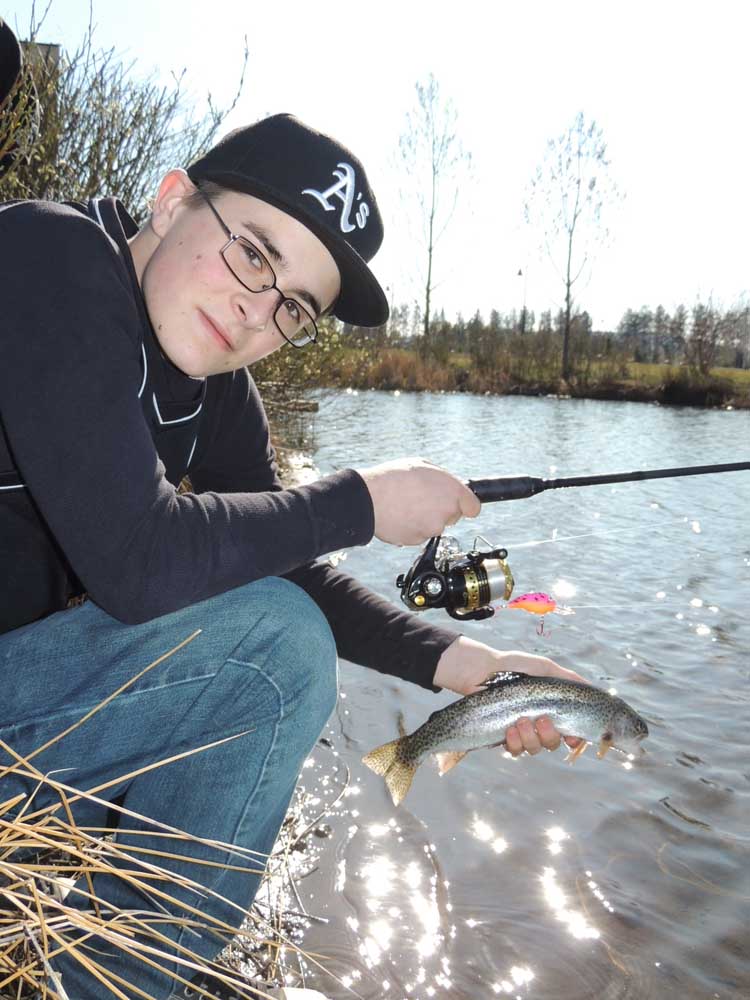Fishing for spring trout in Central Oregon
Published 12:00 am Wednesday, April 16, 2014

- Gary Lewis / For The BulletinBraeden Frederick, 16, holds a holdover rainbow that chased down a pink crankbait.
I could never be a fishing guide. When you take people’s money to take them fishing, there is an expectation fish will be caught. And some days fish don’t bite. Yes, I take people fishing, but just for fun, not for profit.
I took three guys the other day and had a couple of young experts — Tommy Brown and Logan DeGree — along to test some tackle. Someone should have told the fish we were coming, because they showed up late for their own party.
Finally Logan caught one, but the fishing was tough. Braeden, 16, walked back from the other side of the pond. The fly and bubble didn’t work; the pink plastic didn’t work; the spinner didn’t work. He needed a lifeline.
I dove into the tackle bag and opened my crappie box. One lure almost leaped into my hand. I had never seen such enthusiasm in a fat-bodied, scoop-lipped crankbait. It was a Bandit After Shock, pink with an orange belly, black freckles and blood-red hooks. It wanted into the water, bad. “You don’t look like food,” I told it.
We tend to classify lures into neat little categories while the fish look at each bait as a potential meal or threat. We make distinctions based on what we think the trout will eat. But the fish is basically asking two questions: ‘Can I eat it?’ ‘Is it going to eat me?’
With the lure tied on, Braeden stalked around to the other side of the lake and I forgot about him and was talking to Logan when I heard one of my favorite sounds in the world — the rattle of gill plates and the slap of a tail on the water and the clack of a crankbait pinned by a treble in a lip. I cocked an ear and heard it again and saw Braeden battle a nice trout to the bank. On the second cast, the fish bumped it then spun back around and nailed it.
A lot of us think of crankbaits as bass gear, but trout like to think of them as food. It is a reaction bait designed to trigger a response.
In the spring, before the water warms and bug life burgeons, a crankbait can trigger fast limits from some of our best hatchery trout lakes. There is no easier lure to fish. Tie it on and reel it back. The trick is to run the bait down where the feeders are.
They can be anywhere in the water column. If you think fish are deeper, use a deeper running plug. If the fish are in the top 18 inches, use a shorter-lipped bait.
How do you choose from the staggering number of lures on the market? Pick several. Start with a pattern that matches the size of the local bait fish. Then focus on strike trigger details. Small scared fish have big eyes that suggest vulnerability. Glue on stickers or 3-D prisms — make sure it has big eyes. An erratic retrieve suggests fear, and fear provokes a predator. A rattle might be a strike trigger as well, allowing fish to find the lure in murky water.
Red is another strike trigger. When fish feed, they flare their gills, which may be a signal to other fish there’s something to eat. For me, the most dependable trigger color is that dark, bloody gill-colored red.
Many lures show gill flash color already. You can add it with fingernail polish or by changing out one of the hooks. Because predatory trout often strike from the side, I change out the center hook on a three-hook stickbait, swapping the standard bronze for a blood red treble. Rather than hiding the treble, I want that red hook to become the target.
There are lots of good crankbaits on the market, but some of my favorites for hatchery trout are the new Bandit Lure (in pink), Worden’s Timber Tigers, the Rapala Countdown and the Luhr Jensen Hot Lips Express. For fast action, smaller is better.
I don’t care how many trout we catch on crankbaits, for some reason I never tie them on first. Maybe if I was a fishing guide, I would.
— Contact Gary Lewis at www.GaryLewisOutdoors.com.






